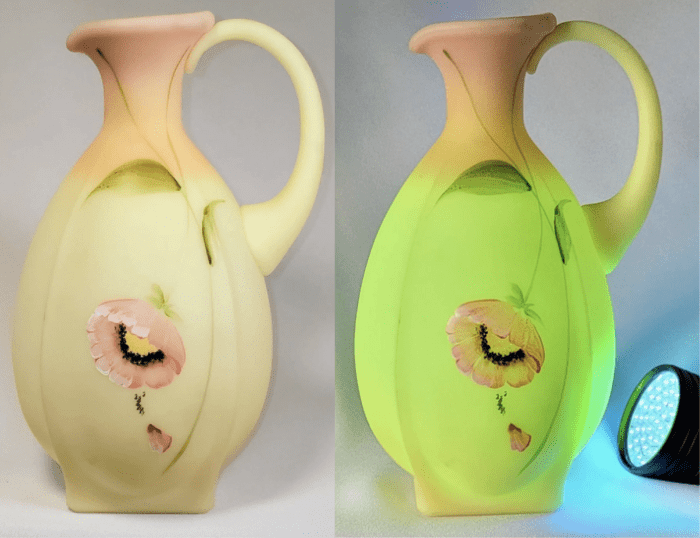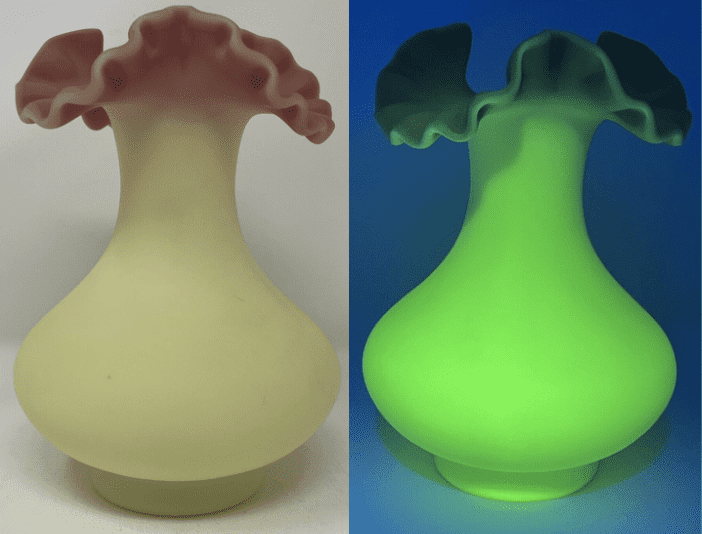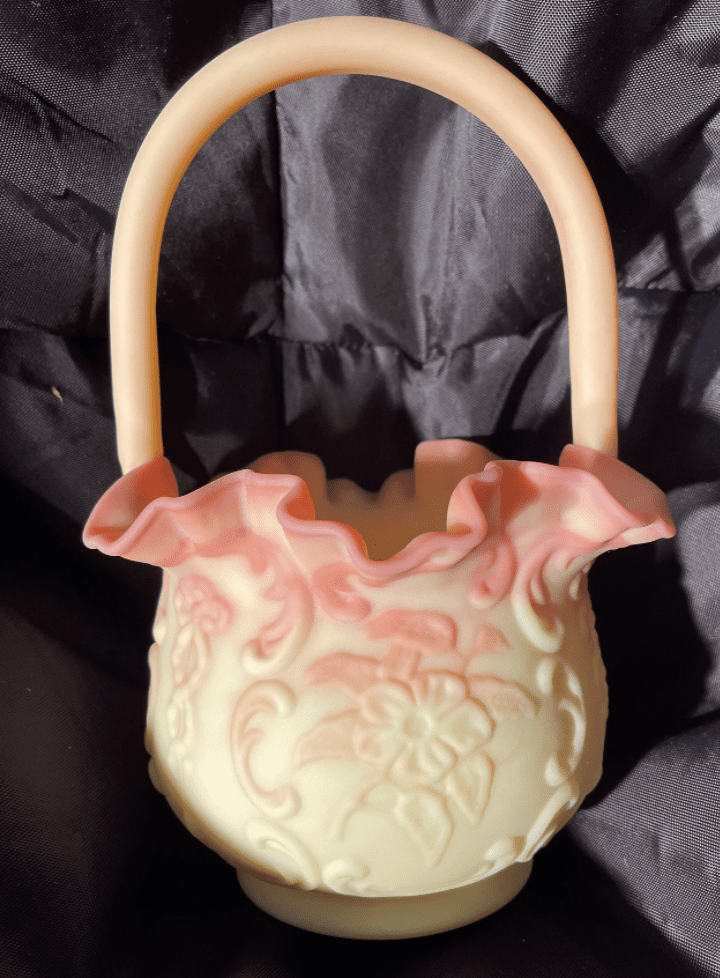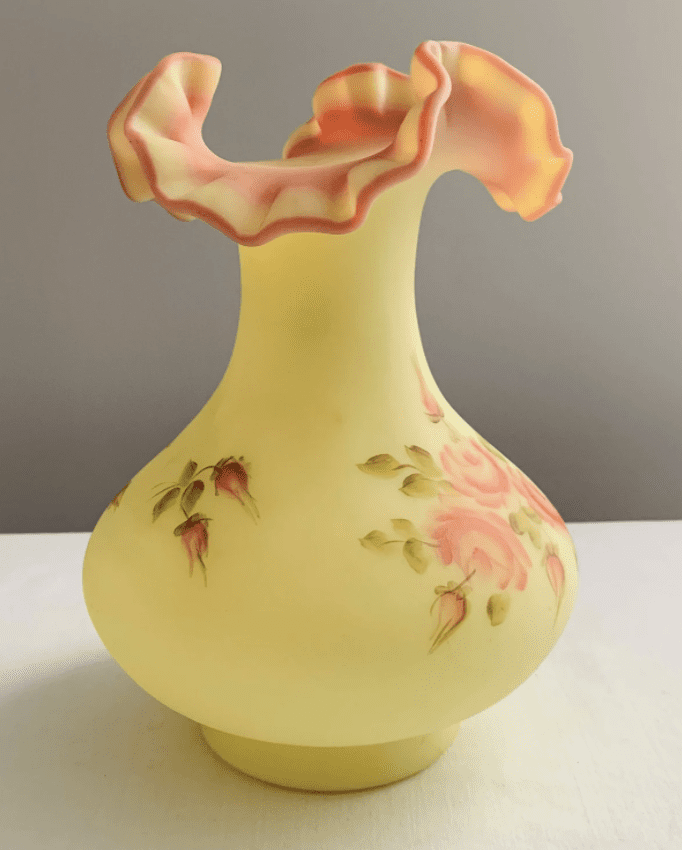If you’re into collecting vintage glass, there’s a good chance you’ve heard of Fenton Burmese glass at some point. In this article, we’ll provide you with an in-depth overview of this type of vintage glass and the history behind it, what makes it unique, and how it’s made.
Fenton Burmese glass is a type of opaque pink and yellow art glass that was made in 1970 by the Fenton Art Glass Company. It contains uranium oxide with traces of gold, which gives the glass its distinctive soft yellow color. It is commonly found with a satin finish or the less common shiny finish.
Fenton Burmese glass is a beautiful vintage glass that would add a level of softness, daintiness, and femininity to any collection. Keep reading to learn all about this special type of antique glass!

Fenton Burmese Glass
What is it?
Burmese glass is easy to spot because of its distinctive color gradient. Its soft yellow color fills the lower section of the glass piece, gradually blending into a soft pink toward the top. The colors blend from pink to yellow so seamlessly that it can often be difficult to know exactly where one color ends and the other begins.
The uranium oxide used to make the glass gives it the yellow color. Fenton Burmese glass refers to Burmese glass made specifically by the Fenton Art Glass Company, as it is not the only or the first company to sell this type of glass.

When Did Fenton Make Burmese Glass?
Burmese glass started being produced by the Fenton Art Glass Company in 1970. Although this type of glass was popular way back in the 1880s, it was difficult to make, so many companies gave up production of it in the early 1900s. Fenton has been making Burmese glass since introducing it in the 1970s, and it is still one of their most successful lines to this day.
Does Fenton Burmese Glass Glow?
Yes! This is one quality that makes this type of vintage glass so unique. Uranium glass is a type of glass that was popular from the 1880s to the 1920s, and Burmese glass is a type of uranium glass. The uranium in the glass causes it to glow bright green under UV/blacklight. Burmese glass proved to be very popular and sold well during Victorian times.
Who Made Burmese Glass and How?
The unique effect of Burmese glass was created by Frederick Shirley at the famous American glass company Mount Washington, and the glass was patented in 1885. Many companies made Burmese glass both inside of the US and abroad in England, but Fenton is one of the most well-known producers of Burmese glass.

Burmese glassware was produced and first patented by the Mount Washington Glass Company of South Boston, Massachusetts. This particular style of art glass used heating and re-heating methods after being hand-blown. Uranium oxide was added to the gold in the translucent white glass to make give it the distinctive yellow color it has become so well-known for.
After being fired in the kiln, the glass would then be opaque. The metallic blend created the duo-toned glass of pale yellow and pink, but some pieces of Burmese glass were made to be brighter yellow and orange in color.

Once completed, the glassware was either given a shiny or dull finish. The dull finish was more popular and profitable when Burmese glass was produced at Mount Washington. After giving the glass either a shiny or dull finish, many would be decorated with different designs on the exterior. Some of the glass pieces had elaborate decorations of enamel and gold added to them, creating intricately designed pieces that are now worth several thousand dollars.
Is Burmese Glass Radioactive?
As we’ve established, due to its uranium content, Burmese glass shines bright green under UV/blacklight. Uranium glass can also register above background radiation on a sufficiently sensitive Geiger counter, a device used to detect and measure ionizing radiation. That being said, keep in mind that most pieces of uranium glass are considered to be harmless and only negligibly radioactive.
Uranium was a common source of yellow and green coloring for glass products for over a century. In the 1940s, it was banned from being used as a constituent in glass so it could instead be used to make the atom bomb. Production of uranium glasses ceased in the United States in the middle of World War II, and the government confiscated uranium supplies for the Manhattan Project from 1942 to 1958. There were also concerns regarding the health of glassworkers who were exposed to the uranium, and both US and UK Governments wanted to restrict access to uranium for military reasons.

These bans on using uranium in glass production were lifted in the 1950s, and some companies today occasionally use uranium as a colorant. It is not as common as it once was, because there are other chemicals that can now be used to produce the same greenish-yellow effect.
It is also less common today because the price of uranium oxide is so high, so there is not likely to be a resurgence of popularity when it comes to uranium glass manufacturing.
With time, there have also come more safety measures for workers, and now there are rigorous control regulations covering protective clothing for workers, lead shielding for storage areas, and monitoring of radiation.
After the restrictions in the United States were eased following WWII, several companies resumed production of uranium glass, including Fenton and Mosser, though uranium was still highly regulated at that point. Restrictions on uranium glass were lifted completely following the Cold War. Boyd Glass and Fenton Art Glass are two USA companies that still produce uranium glass items today, so keep in mind that not every piece of Fenton glass is vintage.
What Is Burmese Satin Glass?
Burmese Satin glass is another name for Burmese glass because this type of glass was commonly given a satin finish, which gives it a more opaque, matte appearance. This effect was achieved by using acid. There are some types of Burmese glass that were given a shiny, glossy finish, but these are less common.


